Busines Model Examples With the Business Model Canvas

The Business Model Canvas is a practical tool to understand how your business creates, delivers, and captures value. In this article, we explore how analyzing your business model can help answer key questions about revenue, costs, and opportunities for improvement. Using a fictional case study, you’ll see how to apply this analysis and why the right tools make a difference.
Business Model Analysis
The Business Model Canvas is useful for describing how a business captures, creates, and delivers value. In this blog, we will elaborate on Business Models, introducing the subject of Business Model Analysis. Analyzing your business model can help to determine whether a venture is, or will be, viable and valuable. After completing a Business Model Canvas for a current or future business model, designers often ask the following questions:
- Where are our revenues coming from?
- What value is delivered to which markets?
- What costs are involved in delivering that value?
- Are our perceived key activities and key resources as important for gaining revenue as we think they are?
- If we change our model in a specific way, what are the effects?
This requires insight into several elements of the business model, the attributes of these elements, and the relations between different elements. Analyzing these elements will provide the foundation for business model change and innovation in an organization.
You can analyze a business model from several different perspectives. In our example, each possibility is analyzed from a different perspective and answers a specific question.
An enterprise architecture tool for business modeling
Using an enterprise architecture tool for Business Modeling is useful since the model is created and stored in a central place, reducing the risk of miscommunication and maximizing the effect of collaboration. Furthermore, communication is made easier through publication functions (html, word, pdf-posters), making the business model more accessible.
Needless to say, this is quite important for models that describe how your company creates value. Especially in the case of Business Model Analysis, tooling can help identify strengths and weaknesses by relating building blocks and providing insight into cash flows by calculations.
Finally, tools help you to work your way “downstream” from your high-level business model to more detailed implementation views e.g. process models, customer journey maps, and enterprise architecture models.
ALSO READ: Discover your choices for an enterprise architecture tool
Practical example: Business Model Canvas for ‘Nextpresso’
We will present several possibilities for analysis on the Business Model Canvas using the case of Nextpresso, a fictional coffee-cup company. To provide some context, the Nespresso machines brew espresso from coffee capsules, a type of pre-apportioned single-use aluminum container of roasted coffee in various flavors. Nextpresso operates in the Dutch coffee market and intends to 'cuppify' the traditional coffee world. The Canvas below presents the current business model of Nextpresso.
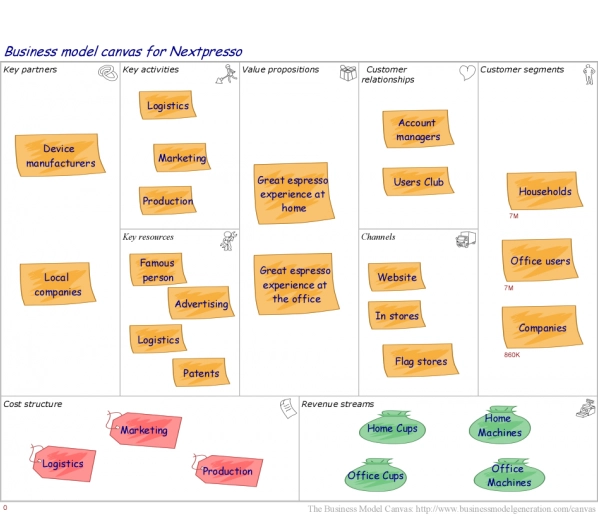
Business Model Canvas made for Nextpresso
Comparison of business models
Comparing different business models is useful in addressing questions, such as: 'If we enter a new market, how will this affect our revenues? If we stop providing certain services, will we decrease our costs? Why is our competitor’s model more successful than ours?' The Nextpresso case offers a good example of such an analysis:
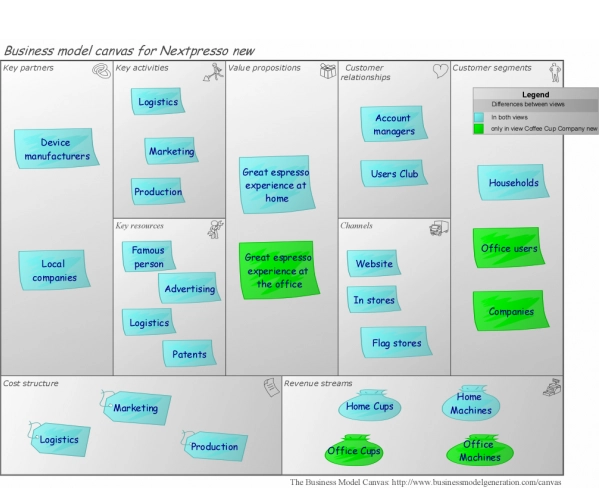
New Business Model Canvas Nextpresso
The Canvas represents the business model of Nextpresso according to the situation before the value proposition ‘Great espresso experience at the office’ was added. At first, Nextpresso provided machines and cups for households only.
You can see the differences in Customer Segments, Channels, Customer Relationships, and Revenue Streams. When elements from the other business model are removed, these elements should be indicated in red.
By knowing these differences, Nextpresso can calculate the differences in revenues and costs before and after this change. In the next example, we will present an example of calculating these costs and revenues.
Typical usage of business model comparison addresses questions regarding GAP analyses (difference between as-is and to-be models), analyses on optional changes to a business model, and comparisons of alternative business models for the future. (Note: the feature to compare business models canvasses is available in Bizzdesign's enterprise architecture tool).
Analyzing Revenues and costs
What value do we deliver to which markets and what costs are involved in providing that value? Where are our revenues coming from? What prices generate what sort of revenues? The ‘Costs and revenues’ function provides a useful way of addressing these questions. Organizations get a simple and clear view of the size of the markets they operate in, revenues per revenue stream, and costs per cost structure.

Costs and Revenues. Business Model Canvas Nextpresso
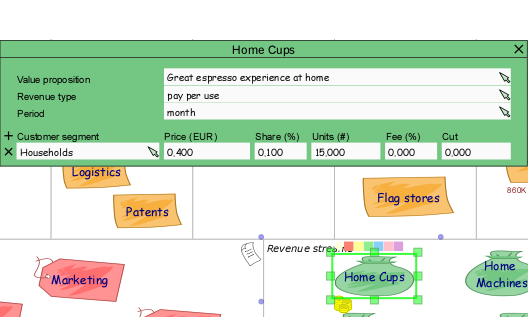
Detailed costs structure. Business Model Canvas Nextpresso
For an overview of revenues and costs, specific information per Cost Structure and Revenue Stream serves as input:
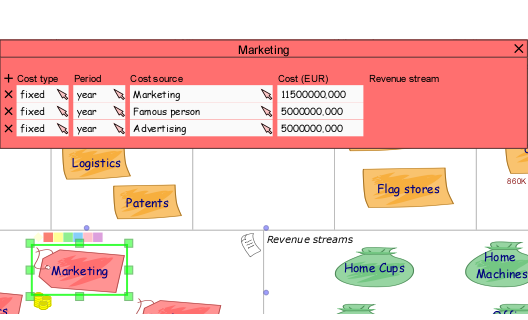
Marketing. Business Model Canvas Nextpresso
Analyzing the customer relations
In the Nespresso case, management might ask: Do we have different operating concepts for our segments ‘Households’, ‘Office users’, and ‘Companies’? Why? How many? An answer can be found by using the Customer Relations Landscape Map in Enterprise Studio:
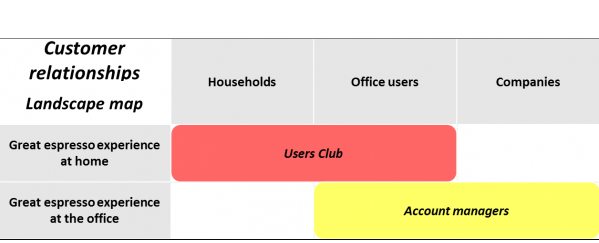
Detailed marketing. Business Model Canvas Nextpresso
Analyzing the channels
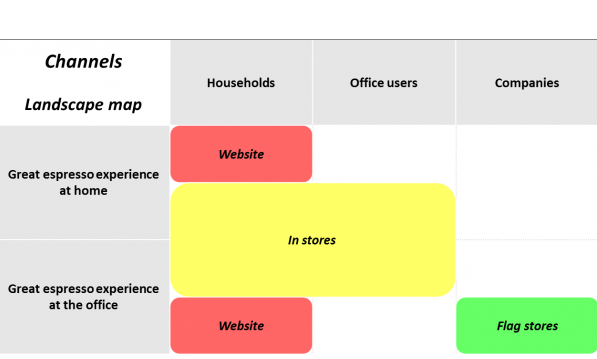
Channels. Business Model Canvas Nextpresso
This Channels Landscape Map may be extended by mapping the Channels on different phases a customer is in (e.g. orientation, comparison, purchase, usage, complaint).
Conclusions and next steps
We described types of analysis, and we zoomed in on analyzing the Business Model Canvas. Analysis of business models answers the question of why and how a venture is or will be, viable and valuable. Based on questions that represent various perspectives on analyzing business models, the Nextpresso case illustrates different approaches to conducting analysis. Choosing the right enterprise architecture tool is essential for business model analyses, making calculations and communication easy. If you would like to see a demo of the Business Model Canvas in Bizzdesign, please contact Bizzdesign's experts for a demo.
FAQs
It helps organizations assess viability, identify strengths and weaknesses, and explore scenarios for growth or transformation.
By visualizing relationships between elements, organizations can test new value propositions, channels, or customer segments before implementation.
Tools like Bizzdesign enable scenario comparisons, cost/revenue calculations, and integration with downstream models (e.g., processes, customer journeys).



